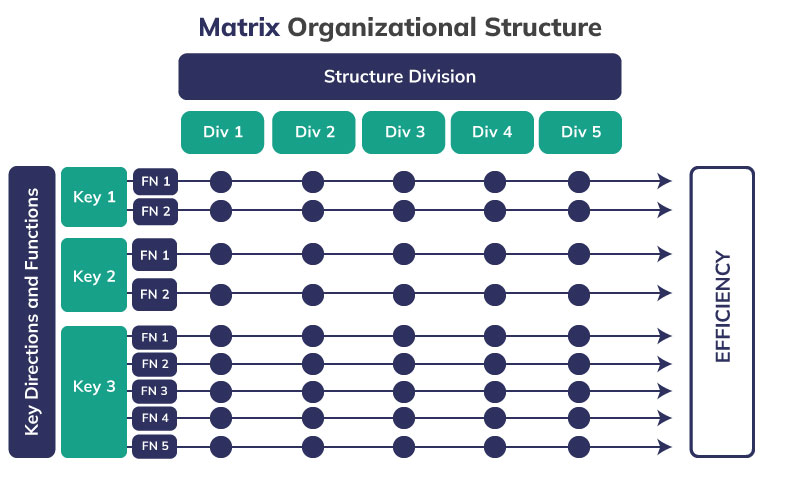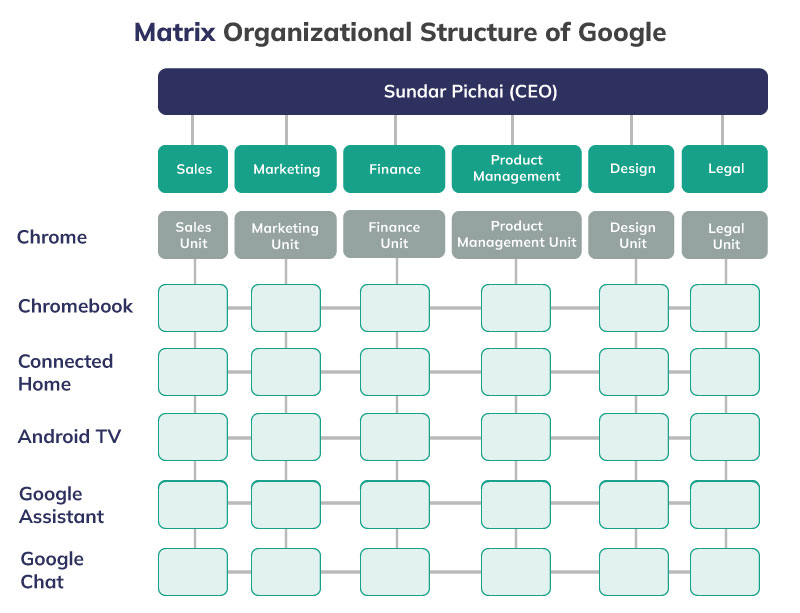Introduction to Matrix Organizational Structure
With the increase in business complexities, the hierarchical organizational structure is becoming more inadequate. At the same time, it is also becoming evident that there is no one best way to manage the business processes. This results in an increased need for the organizations to adopt the matrix organizational structure which includes the presence of multidisciplinary teams to manage various business functions.
A matrix organizational structure is a combination of two or more organizational structures in which the reporting relations are managed in a grid and matrix rather than the traditional hierarchies. The matrix organizational structure includes dual reporting relations which generally include functional and product divisional managers. Hence, the matrix organizational structure includes two chains of command.
Table of Contents

Thus, matrix organizational structure is the mix of two or more organizational structures and helps to foster cross-team collaboration in the organization. However, the matrix organizational structure also includes complexity and confusion regarding the authority due to dual reporting.
Advantages of Matrix Organizational Structure
The matrix organizational structure offers several benefits to the organization which far outweigh the complexity of this organizational structure. The advantages of matrix organizational structural structure are discussed as follows-
Communication efficiency- Matrix organizational structure improves communication efficiency in the organization as employees are required to answer to multiple managers. The information dissemination is also effective in the matrix organizational structure due to the horizontal and vertical flow of information in this structure.
Clear objectives- The Matrix organizational structure can also help to ensure greater clarity regarding the project as the matrix organizational structure helps to solidify the project objectives. Moreover, the clear line of communication and authority in the organization also helps in maintaining clarity in the organization.
Efficient use of resources- Matrix organizational structure promotes efficient use of resources in the organization because specialists from various departments work collaboratively to manage various project activities which help to reduce overhead costs as well as the amount of time needed to complete various tasks.
Employee motivation- The level of employee motivation is higher when the employees work with higher autonomy in the team. The matrix organizational structure provides a better sense of teamwork in the organization which also helps to encourage employee contribution in the organization.
Employee professional development- Matrix organizational structure also allows professional development of the employees by exposing employees to multiple tasks. Being engaged in various tasks helps to improve the employee’s skills and capabilities.
Disadvantages of Matrix Organizational Structure
Despite the advantages of the matrix organizational structure, the matrix organizational structure also has various disadvantages which are discussed as follows-
Authority confusion- Matrix organizational structure requires the employees to report to two or more managers which results in confusion among the employees regarding their roles and responsibilities. The difference in the opinion of the two managers can also lead to confusion among the employees about their roles.
Complexity- Matrix organizational structure is more complex than the functional organizational structure due to dual chain of command and complex information flow. Conflicting issues can also be faced in the organization when the two project managers or departmental heads compete for similar resources. The complexity in the management processes can also make it difficult for the team members to set the priorities for various tasks due to differences in opinion of each functional or departmental head.
Decline in employee effectiveness- The employee effectiveness in the organization may also decline when the employees are assigned multiple tasks and are required to report to multiple managers. The role ambiguity in the matrix organizational structure can also cause a decline in the effectiveness of the employees in the organization.
Exemplification of Matrix Organizational Structure
Most of the large organizations in the current times adopt the matrix organizational structure as the matrix organizational structure helps the large business organizations to effectively manage various cross functions in the organizations. Can you guess any such organization? Yes, Nike, Google, Starbucks, etc. all operate under the matrix organizational structure. Let’s have a look at the matrix organizational structure of Google.
The organizational structure of Google is an amalgamation of divisional, functional, and team-based organizational structures which is one of the main reasons for its organizational success. The matrix-based organizational structure at Google enables the company to effectively manage the cross-functional teams and coordinate the business processes. The organizational structure of Google is represented as follows-

Functional organizational structure- The corporate structure of Google uses functions as the base for organizing employees. The employees are divided based on several functions which include sales, marketing, engineering, design, product management, finance, legal and human resource. Each function is headed by an executive who is responsible to implement organization-wide strategies for managing various business functions. For instance, the product manager at Google is responsible to conceptualize new product ideas and create product roadmaps.
Product-based organizational structure- The product-based grouping of Google is aimed at categorizing the operations of the organization according to the different lines of products. The different product divisions of Google include Chrome, Chromebook, Connected Home, Calendar, Android TV, Android OS, Google Assistant, Google Chat, Google Classroom, YouTube, and many more. The product groups enable the organization to ensure that new products are created considering the needs of the customers and their existing products are managed considering customer satisfaction. The product division heads are responsible for implementing innovative ideas and ensuring customer satisfaction.
Flat organizational structure- Despite the functional and product divisions, Google also adopts the flat organizational structure under which every employee is allowed to provide their suggestions for various issues. The flat organizational structure and employee engagement in the organization also help to promote innovation at the workplace and make employees feel valued. This helps the organization to promote intelligence and less seniority in the organization. Hence, the organizational structure of Google helps in creating flexible working conditions and enhancing the work efficiency of the employees.
The amalgamation of two or more organizational structures at Google helps the organization to promote innovation in the organization. The key advantage of the matrix organizational structure at Google structures is an increase in the organization’s productivity and effective communication within the organization.
FAQs
How to successfully implement matrix organization structure?
Here are a few tips to successfully implement matrix organization structure:
- Uplift a positive culture in your organization
- Assign clear roles and responsibilities to your employees
- Maintain effective communication methods
When is a matrix organizational structure most appropriate?
A matrix structure is best suited for organizations that frequently handle complex projects that require the collaboration of various functional departments. It is also suitable when flexibility and adaptability are essential due to rapidly changing environments.
Previous Structure
Vertical Organizational StructureNext Structure
Centralized Organizational Structure
 Proof Reading
Proof Reading  Copy Writing
Copy Writing  Resume Writing
Resume Writing  Blogs
Blogs Guides
Guides SOP's
SOP's Student Resources
Student Resources Research Topics
Research Topics Login
Login Register
Register